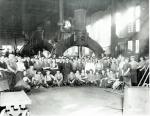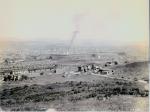![header=[Marker Text] body=[The PRR built its first repair facilities here in 1850 and opened its first track to Altoona during the same year. By 1925, Altoona was home to the nation's largest concentration of railroad shops, with 16,500 people employed in several locations] sign](http://explorepahistory.com/kora/files/1/10/1-A-1D6-139-ExplorePAHistory-a0b2g8-a_450.gif)
Mouse over for marker text
Name:
Pennsylvania Railroad Shops
Region:
Laurel Highlands/Southern Alleghenies
County:
Blair
Marker Location:
9th Ave. at 13th St., Altoona
Dedication Date:
October 5, 1996
Behind the Marker
No city in America can claim to be as much of a railroad town as Altoona. Situated midway between the Pennsylvania Railroad's (PRR) original terminal points of Harrisburg and Pittsburgh,  Altoona for generations was the site of the railroad's enormous locomotive and car shops. At the peak of operations in 1925, the Altoona PRR shops employed about 16,500 workers. Thousands more were members of train crews or the dispatching staff, or worked in the engine houses, and freight yards, and on track-maintenance and signal gangs.
Altoona for generations was the site of the railroad's enormous locomotive and car shops. At the peak of operations in 1925, the Altoona PRR shops employed about 16,500 workers. Thousands more were members of train crews or the dispatching staff, or worked in the engine houses, and freight yards, and on track-maintenance and signal gangs.
The PRR built its first repair facility in Altoona in 1850, the same year it opened its line there from Harrisburg. By 1855, the railroad shops in Altoona employed about 1,000 people. In 1875, the complex consisted of three engine houses, an iron and brass foundry, machine shops, boiler shop, paint shops, blacksmith shops, coaling platform, freight-car works, passenger-car shop, planning mill, tin and cabinet shop, upholstery shop, storehouses, fire-engine house, and lumber-drier.
PRR bought locomotives by the thousands from the Baldwin Locomotive Works of Philadelphia and other manufacturers. Unlike most railroads, it also built its own steam locomotives in great quantities. Indeed, Altoona turned out 6,873 locomotives, the vast majority of them steam engines, from 1866 to 1946. Altoona's shops also built tens of thousands of freight and passenger cars, and maintained and repaired PRR's vast fleet of engines and cars.
Baldwin Locomotive Works of Philadelphia and other manufacturers. Unlike most railroads, it also built its own steam locomotives in great quantities. Indeed, Altoona turned out 6,873 locomotives, the vast majority of them steam engines, from 1866 to 1946. Altoona's shops also built tens of thousands of freight and passenger cars, and maintained and repaired PRR's vast fleet of engines and cars.
The city grew to support the shops and its workforce, which in turn grew to support the railroad. In 1853, PRR carried a total of 157,000 tons of freight. By 1900, the volume approached sixty-seven million tons, a 400-fold increase. In 1854, when the Horseshoe Curve opened, the railroad carried about 150,000 passengers; by 1890, the figure was twenty million.
By the early 1900s, PRR's shops expanded to cover 242 acres, with 122 buildings divided into four complexes: Altoona Machine Shops, Altoona Car Shops, Juniata Shops, and South Altoona Foundries. The East Altoona roundhouse, one of the largest in the world, served the PRR's day-to-day rail operations. Built in 1904, it measured 395 feet in diameter and serviced 300 locomotives a day from the railroad's Middle and Pittsburgh divisions.
Drawn by steady and comparatively well-paying jobs with the railroad, immigrants from all over Europe moved to Altoona, where they settled into neighborhoods and workplaces filled with fellow countrymen. Altoona's population more than doubled between 1900 and its peak year of 1930 - from 39,000 to 82,000 people. In the railroad shops, English, Welsh, Scottish, and German workers got most of the supervisory and foremen's jobs, while Italians and a few Eastern Europeans found their options limited to common laboring jobs.
Although, or perhaps because, the city had a large workforce under a single employer, union agitation and labor trouble was minimal. During the 1877 railroad riots in Pittsburgh and elsewhere in Pennsylvania, work at the Altoona shops was disrupted but not stopped. To prevent unionization of its workforce, the railroad created company unions with labor-management councils that kept out the independent unions. In 1911, and again in 1922, when strikes elsewhere threatened to boil over into the Altoona shops, PRR made its position clear: If trouble erupts, we will move the shops elsewhere. A statement issued by PRR to the press in 1911 painted a bleak scenario:
1877 railroad riots in Pittsburgh and elsewhere in Pennsylvania, work at the Altoona shops was disrupted but not stopped. To prevent unionization of its workforce, the railroad created company unions with labor-management councils that kept out the independent unions. In 1911, and again in 1922, when strikes elsewhere threatened to boil over into the Altoona shops, PRR made its position clear: If trouble erupts, we will move the shops elsewhere. A statement issued by PRR to the press in 1911 painted a bleak scenario:
A strike would mean the elimination of 6,000 employees, a reduction of 25,000 in the population of the city, and the consequent loss of $400,000 per month; to say nothing of the number of unemployed citizens, the ultimate untenanted properties, and the consequent depreciation in all property values.
When a nationwide shop men's strike in 1922 crippled many railroads, the shops at Altoona were virtually unaffected; workers refused to join the strike, knowing that if they lost their jobs, Altoona offered almost no other employment options. An exceptionally high percentage of home ownership - spurred by a large number of savings-and-loan institutions in Altoona - meant that workers were less likely to pull up roots and move on. Among staunch unionists elsewhere, this notable reluctance to oppose management gave the city the nickname "scab town."
For decades, PRR led the American railroad industry's fight against unionization, and in the 1920s successfully weakened the power of the federal Railroad Labor Board through court challenges. It was not until the 1930s, when New Deal legislative reforms gave legal backing to independent unions and outlawed company unions, that shop workers won the right to organize.
After World War II, Altoona became a veritable poster child for the woes of one-industry towns. When diesel locomotives replaced steam engines on the nation's railroads, the need for such extensive rail shops vanished. PRR closed one shop after another, putting thousands of skilled machinists out of work. Even the building of a new freight-car shop in nearby Hollidaysburg in 1955 did not reverse the trend. Conrail, which took over what remained of the facilities in 1976, kept the Altoona shops open to repair its system-wide diesel locomotives, but employment continued to drop. In 1999, Norfolk Southern Corporation acquired 60 percent of the Conrail system, including the Altoona shops. Today the shops employ around one thousand people - about the same as in 1855.
The PRR built its first repair facility in Altoona in 1850, the same year it opened its line there from Harrisburg. By 1855, the railroad shops in Altoona employed about 1,000 people. In 1875, the complex consisted of three engine houses, an iron and brass foundry, machine shops, boiler shop, paint shops, blacksmith shops, coaling platform, freight-car works, passenger-car shop, planning mill, tin and cabinet shop, upholstery shop, storehouses, fire-engine house, and lumber-drier.
PRR bought locomotives by the thousands from the
The city grew to support the shops and its workforce, which in turn grew to support the railroad. In 1853, PRR carried a total of 157,000 tons of freight. By 1900, the volume approached sixty-seven million tons, a 400-fold increase. In 1854, when the Horseshoe Curve opened, the railroad carried about 150,000 passengers; by 1890, the figure was twenty million.
By the early 1900s, PRR's shops expanded to cover 242 acres, with 122 buildings divided into four complexes: Altoona Machine Shops, Altoona Car Shops, Juniata Shops, and South Altoona Foundries. The East Altoona roundhouse, one of the largest in the world, served the PRR's day-to-day rail operations. Built in 1904, it measured 395 feet in diameter and serviced 300 locomotives a day from the railroad's Middle and Pittsburgh divisions.
Drawn by steady and comparatively well-paying jobs with the railroad, immigrants from all over Europe moved to Altoona, where they settled into neighborhoods and workplaces filled with fellow countrymen. Altoona's population more than doubled between 1900 and its peak year of 1930 - from 39,000 to 82,000 people. In the railroad shops, English, Welsh, Scottish, and German workers got most of the supervisory and foremen's jobs, while Italians and a few Eastern Europeans found their options limited to common laboring jobs.
Although, or perhaps because, the city had a large workforce under a single employer, union agitation and labor trouble was minimal. During the
A strike would mean the elimination of 6,000 employees, a reduction of 25,000 in the population of the city, and the consequent loss of $400,000 per month; to say nothing of the number of unemployed citizens, the ultimate untenanted properties, and the consequent depreciation in all property values.
When a nationwide shop men's strike in 1922 crippled many railroads, the shops at Altoona were virtually unaffected; workers refused to join the strike, knowing that if they lost their jobs, Altoona offered almost no other employment options. An exceptionally high percentage of home ownership - spurred by a large number of savings-and-loan institutions in Altoona - meant that workers were less likely to pull up roots and move on. Among staunch unionists elsewhere, this notable reluctance to oppose management gave the city the nickname "scab town."
For decades, PRR led the American railroad industry's fight against unionization, and in the 1920s successfully weakened the power of the federal Railroad Labor Board through court challenges. It was not until the 1930s, when New Deal legislative reforms gave legal backing to independent unions and outlawed company unions, that shop workers won the right to organize.
After World War II, Altoona became a veritable poster child for the woes of one-industry towns. When diesel locomotives replaced steam engines on the nation's railroads, the need for such extensive rail shops vanished. PRR closed one shop after another, putting thousands of skilled machinists out of work. Even the building of a new freight-car shop in nearby Hollidaysburg in 1955 did not reverse the trend. Conrail, which took over what remained of the facilities in 1976, kept the Altoona shops open to repair its system-wide diesel locomotives, but employment continued to drop. In 1999, Norfolk Southern Corporation acquired 60 percent of the Conrail system, including the Altoona shops. Today the shops employ around one thousand people - about the same as in 1855.
Beyond the Marker






